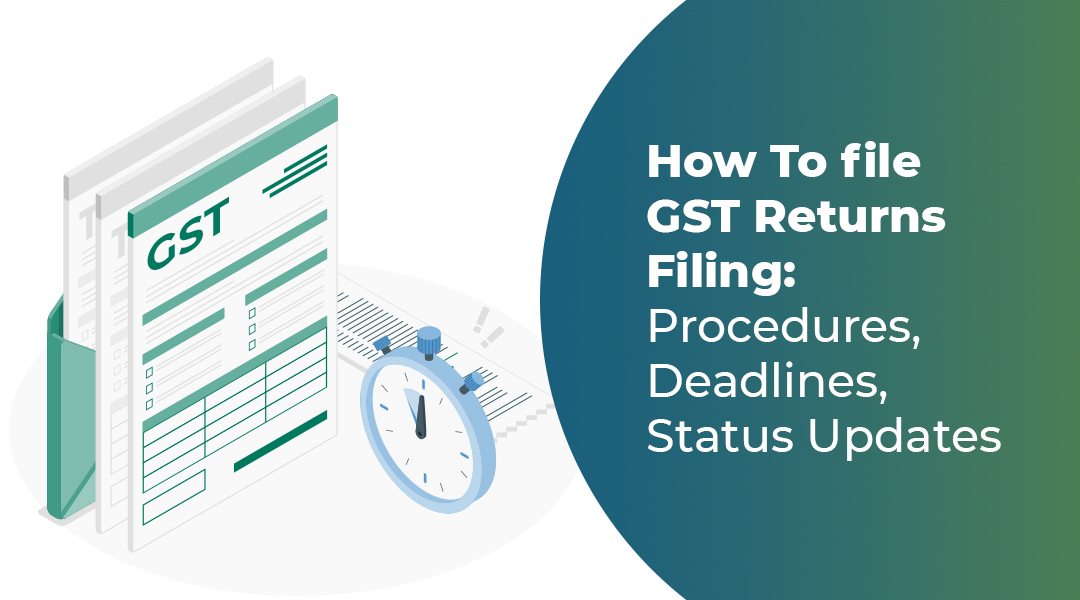The Goods and Services Tax (GST) is a comprehensive indirect tax on the manufacture, sale, and consumption of goods and services throughout India. It has replaced multiple cascading taxes levied by the central and state governments. As a business owner, it is crucial to understand the process of filing GST returns, the various types of returns, deadlines, and how to track the status of your returns. This article provides a complete guide on the procedures, deadlines, and status updates for GST returns filing.
Understanding GST Returns
A GST return is a document containing details of income/ sales and expenses/ purchases made by a GST-registered taxpayer. It is used by tax authorities to calculate the net tax liability. The GST return filing process includes the submission of information related to purchases, sales, output GST (on sales), and Input Tax Credit (GST paid on purchases).
Types of GST Returns
There are several types of GST returns that taxpayers need to file based on their business activities and turnover. Some of the primary GST return forms include GSTR-1, GSTR-3B, GSTR-4, GSTR-5, GSTR-6, GSTR-7, GSTR-8, GSTR-9, GSTR-10, CMP-08, and ITC-04. Each return form serves a specific purpose and is applicable to different types of taxpayers.
Who Should File GST Returns?
All GST-registered businesses must file GST returns, regardless of their turnover or type of business. The frequency and due dates for filing these returns depend on the business’s annual aggregate turnover and the chosen scheme (such as the Quarterly Return Monthly Payment (QRMP) scheme for small taxpayers).
GST Return Filing Procedure
Filing GST returns online is a straightforward process that can be completed through the GST portal. Follow the steps below to file your GST returns:
1. Register for GSTIN
If you are not yet registered under GST, you must first register to obtain a GST Identification Number (GSTIN). This 15-digit number is generated based on your state code of operation and Permanent Account Number (PAN).
2.Log into the GST Portal
Log in to the GST portal using your username and password. Click on the ‘Services’ tab to access the returns dashboard.
3. Select Financial Year and Return Type
Choose the appropriate financial year for which you are filing the return from the drop-down menu. Next, select the return type that is applicable to your business.
4. Prepare Online and Enter the Details
After selecting the return type, click on the ‘Prepare Online’ option and enter all the required details in the fields provided. Ensure that you include any pending late fees, if applicable. Save the form and submit it.
5. Check the Submission Status
Once the form is submitted, verify that the status of the GST return has changed to ‘Submitted’.
6. Tax Payment and Offset Liability
When the status shows that the return has been submitted, click on ‘Payment of Tax’ and then ‘Check Balance’ to view your credit and cash balance. To make the GST payment, click on ‘Offset Liability’, confirm the declaration, and proceed with the payment using the ‘File Form with DSC’ or ‘File Form with EVC’ option.
Remember that each GST return form may have additional or fewer steps than the general process outlined above. Detailed instructions for each form can be found on the official GST website. It is advisable to keep all necessary information and documents handy while filing GST returns. Using a software solution like TallyPrime can help minimize errors during the filing process.
Deadlines for Filing GST Returns
The deadlines for filing GST returns vary depending on the type of return and the taxpayer’s specifics. Below are the general deadlines for some common GST returns:
- GSTR-1: 11th of the month following the tax period (monthly) or 13th of the month following the quarter (for taxpayers under the QRMP scheme).
- GSTR-3B: 20th of the month following the tax period (monthly) or 22nd/ 24th of the month following the quarter (for taxpayers under the QRMP scheme).
- GSTR-4: 30th of the month following the financial year (annual return for composition taxpayers).
- GSTR-5, GSTR-5A, GSTR-6, GSTR-7, and GSTR-8: 20th, 20th, 13th, 10th and 10th of the month following the tax period, respectively (all monthly returns).
- GSTR-9 and GSTR-9C: 31st December of the following financial year (annual returns).
Please note that these deadlines may be subject to changes based on notifications or orders from the Central Board of Indirect Taxes and Customs (CBIC).
Tracking GST Return Status
After filing your GST returns, you can track their status through the GST portal. Log in to your account, click on the ‘Services’ tab, and select ‘Returns > Track Return Status’. Enter the relevant financial year, return filing period, and return type to view the status of your filed returns.
Revisions and Amendments to GST Returns
If you have made any errors or omissions in your GST returns, you can rectify them in the subsequent return filing period. For example, if you have missed reporting an invoice in GSTR-1, you can include it in the next month’s return. However, it is essential to ensure that the corrections are made within the financial year or before the filing of the annual return, whichever is earlier.
GST Return Filing for Special Cases
There are specific situations where taxpayers need to file additional or separate returns. These include the following:
- Composition dealers: They must file a quarterly statement-cum-challan (CMP-08) and an annual return (GSTR-4).
- Taxpayers under the QRMP scheme: They must file quarterly GSTR-1 and GSTR-3B returns, along with monthly PMT-06 for tax payment.
- Taxpayers with a Unique Identity Number (UIN): They must file a monthly GSTR-11 return to claim a refund of taxes paid on their inward supplies.
Conclusion
Filing GST returns is crucial for businesses operating in India. Understanding the different types of returns, their deadlines, and the procedures involved is essential to maintain compliance with the GST regime and avoid penalties. Utilizing software solutions and staying updated with the latest GST notifications are key strategies to ensure smooth and accurate GST return filing. To make learning about GST easier, consider enrolling in GGC’s Practical Training Academy (GGCPTA), which offers short-term finance course including specialized GST training. GGCPTA is a well-known brand in the field, providing expert guidance from experienced finance professionals.




